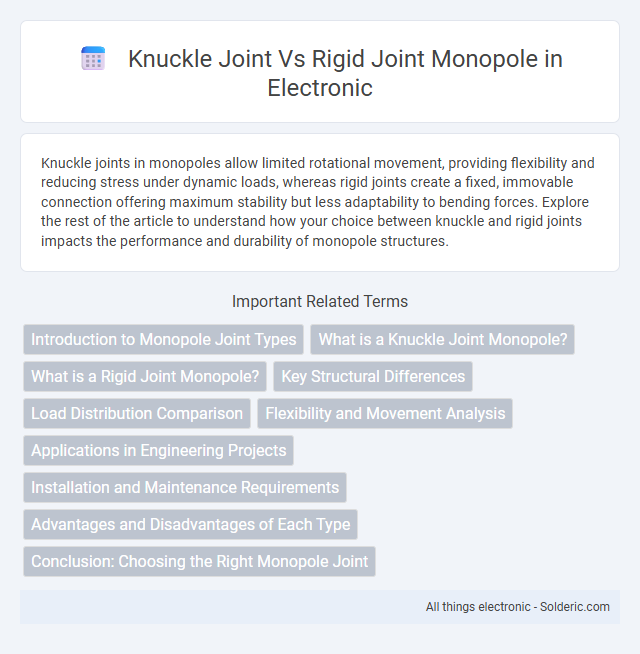Knuckle joints in monopoles allow limited rotational movement, providing flexibility and reducing stress under dynamic loads, whereas rigid joints create a fixed, immovable connection offering maximum stability but less adaptability to bending forces. Explore the rest of the article to understand how your choice between knuckle and rigid joints impacts the performance and durability of monopole structures.
Comparison Table
| Feature | Knuckle Joint Monopole | Rigid Joint Monopole |
|---|---|---|
| Connection Type | Flexible, allows rotation | Fixed, no rotation |
| Structural Behavior | Accommodates movement, reduces stress | Maintains shape, higher stiffness |
| Applications | Used where angular adjustments are necessary | Used for stable, non-movable structures |
| Load Handling | Handles dynamic, fluctuating loads | Handles static loads primarily |
| Maintenance | Requires regular checks due to moving parts | Low maintenance |
| Cost | Higher due to complexity | Lower, simpler design |
Introduction to Monopole Joint Types
Monopole structures utilize knuckle joints to allow rotational movement and flexibility, enhancing the durability and adaptability of towers under dynamic loads such as wind and seismic activity. Rigid joints in monopoles provide fixed connections that ensure structural stability and load distribution, crucial for maintaining overall shape and strength in static conditions. Choosing between knuckle joint and rigid joint monopoles depends on factors like environmental stress, design requirements, and maintenance considerations.
What is a Knuckle Joint Monopole?
A knuckle joint monopole is a type of telecommunications tower that incorporates a hinged connection, allowing segments to rotate relative to each other for easier transportation and installation. This design contrasts with rigid joint monopoles, which have fixed, non-movable connections providing greater structural stability but reduced flexibility. Knuckle joint monopoles are preferred in locations where logistical constraints make assembly or maintenance challenging, as their modular and hinged sections enable quick erection and compact shipping.
What is a Rigid Joint Monopole?
A Rigid Joint Monopole is a type of telecommunications tower designed with solid, fixed connections that provide enhanced structural stability and load-bearing capacity. Unlike knuckle joint monopoles, which use flexible connectors for easier assembly and maintenance, rigid joint monopoles offer greater resistance to wind and environmental stresses. These towers are commonly used for mounting antennas and other equipment requiring consistent alignment and durability over long periods.
Key Structural Differences
Knuckle joint monopoles feature a hinge-like connection allowing controlled angular movement, enhancing flexibility under wind loads, while rigid joint monopoles maintain a fixed, immovable connection for maximum structural stiffness. The knuckle joint's design incorporates pins and bearings that accommodate bending moments, contrasting with the solid weld or bolted connections in rigid joints that resist rotation. Your choice depends on load conditions and maintenance preferences, as knuckle joints may require more frequent inspection than the simpler rigid joints.
Load Distribution Comparison
Knuckle joints in monopoles provide flexibility allowing slight rotational movement, which helps distribute dynamic loads like wind and vibrations more evenly along the structure, reducing stress concentrations. Rigid joints, however, transfer loads directly and cause higher stress at the connection points due to limited movement, resulting in more localized load concentration. This makes knuckle joints preferable for monopoles subjected to fluctuating or lateral loads, enhancing durability and reducing fatigue failure risk.
Flexibility and Movement Analysis
Knuckle joint monopoles offer superior flexibility by allowing controlled rotational movement, which helps absorb dynamic loads such as wind sway and seismic forces, reducing structural stress. Rigid joint monopoles, in contrast, provide minimal movement due to their fixed connections, leading to higher stress concentrations but enhanced overall stability under static loads. The selection depends on balancing flexibility requirements for dynamic conditions against rigidity for structural integrity.
Applications in Engineering Projects
Knuckle joints are commonly used in engineering projects requiring flexibility and angular movement, such as crane arms and mechanical linkages, allowing for controlled articulation under varying loads. Rigid joint monopoles provide enhanced structural stability and are frequently employed in telecommunications towers and support columns where minimal movement and high load-bearing capacity are essential. Your choice between these joint types influences the durability and functionality of structures under dynamic or static conditions.
Installation and Maintenance Requirements
Knuckle joint monopoles require more frequent maintenance due to the presence of movable parts that can wear over time, necessitating regular lubrication and inspection to ensure structural integrity. Rigid joint monopoles offer simpler installation processes with fixed components that reduce the likelihood of mechanical failure and consequently lower overall maintenance demands. You should consider knuckle joints for flexibility in height adjustment, while rigid joints provide long-term durability with less upkeep.
Advantages and Disadvantages of Each Type
Knuckle joint monopoles offer the advantage of flexibility, allowing slight movement to withstand wind loads and reduce structural stress, but they require regular maintenance to prevent joint wear and potential loosening. Rigid joint monopoles provide greater structural stability and require less maintenance due to fixed connections, yet they are less forgiving under dynamic loads, which can lead to higher stress concentrations and possible material fatigue. Choosing between knuckle and rigid joint monopoles depends on site conditions, load demands, and maintenance capabilities, balancing flexibility against robustness.
Conclusion: Choosing the Right Monopole Joint
Selecting the right monopole joint depends on the application's need for flexibility versus rigidity; knuckle joints provide enhanced movement and shock absorption, ideal for dynamic loads and variable wind conditions. Rigid joints offer maximum stability and structural integrity, suitable when minimal deflection is critical for your communication equipment. Understanding these differences ensures your monopole installation achieves optimal performance and longevity.
knuckle joint vs rigid joint monopole Infographic

 solderic.com
solderic.com